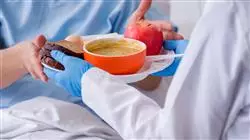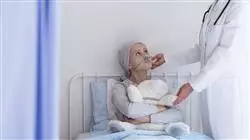University certificate
The world's largest faculty of nursing”
Introduction to the Program
A complete qualification that will help you to learn the main tools and innovations in nutrition in the field of oncology”

Nurses are the main professionals who provide care to oncology patients. Within their scope of action, nutrition is an essential pillar, both in the prevention and treatment of cancer, so it is essential that the student acquires complete and up to date knowledge on the nutritional approach to the oncology patient. Malnutrition is a frequent problem that causes a large number of complications in cancer patients, reducing their quality of life and worsening their general condition. For this reason, it is essential to know the causes and factors involved and to detect early the clinical manifestations of these patients in order to provide the appropriate care and nutritional support.
In their last moments, the patient presents a characteristic symptomatology, with specific needs that must be known and learned to address. This program will provide students with the necessary tools to detect the most common signs and symptoms at this stage of the disease, as well as strategies to provide the most appropriate treatment and alleviate suffering at this time of life.
In this way, TECH has designed the update of the contents of this Postgraduate diploma with an integrative approach that will result in a complete vision of all aspects related to oncology nursing. The elaborate syllabus will provide a journey through the diverse needs of cancer patients, whose particularities require personalized attention.
Both the design of the program and the educational material used will facilitate the understanding of concepts, and the realization of practical cases will help to adapt what has been learned to daily practice. In this way, the completion of the Postgraduate diploma will provide immersive learning to achieve the professional's specialization in real situations of their usual professional practice.
Don’t miss this opportunity to study in the biggest private online university”
This Postgraduate diploma in Oncology Patient Care. Nutrition and Nursing Communication contains the most complete and up-to-date scientific program on the market. The most important features include:
- The development of case studies presented by experts in Oncology Nursing
- The graphic, schematic, and practical contents with which they are created, provide scientific and practical information on the disciplines that are essential for professional practice
- What's new in oncology nursing: tumor types, oncology treatment and administration
- Practical exercises where self-assessment can be used to improve learning
- Special emphasis on innovative methodologies in Oncology Nursing
- Theoretical lessons, questions to the expert, debate forums on controversial topics, and individual reflection assignments
- Content that is accessible from any fixed or portable device with an Internet connection
This Postgraduate diploma is the best investment you can make in selecting a refresher program to update your knowledge in Oncology Nursing”
Its teaching staff includes professionals from the field of nursing Dermatology, who bring their experience to this Postgraduate Diploma program, as well as renowned specialists from leading communities and prestigious universities.
The multimedia content, developed with the latest educational technology, will provide the professional with situated and contextual learning, i.e., a simulated environment that will provide immersive learning programmed to study in real situations.
The design of this program focuses on Problem-Based Learning, by means of which the specialist must try to solve the different professional practice situations that arise throughout the program. To do so, they will be assisted by an innovative interactive video system created by recognized experts in the Oncology Nursing with extensive experience.
The best teaching material in a high-quality program that will facilitate your learning in a contextual approach"

This 100% online Postgraduate diploma will allow you to balance your studies with your professional work while expanding your knowledge in this field"
Why study at TECH?
TECH is the world’s largest online university. With an impressive catalog of more than 14,000 university programs available in 11 languages, it is positioned as a leader in employability, with a 99% job placement rate. In addition, it relies on an enormous faculty of more than 6,000 professors of the highest international renown.

Study at the world's largest online university and guarantee your professional success. The future starts at TECH”
The world’s best online university according to FORBES
The prestigious Forbes magazine, specialized in business and finance, has highlighted TECH as “the world's best online university” This is what they have recently stated in an article in their digital edition in which they echo the success story of this institution, “thanks to the academic offer it provides, the selection of its teaching staff, and an innovative learning method aimed at educating the professionals of the future”
A revolutionary study method, a cutting-edge faculty and a practical focus: the key to TECH's success.
The most complete study plans on the university scene
TECH offers the most complete study plans on the university scene, with syllabuses that cover fundamental concepts and, at the same time, the main scientific advances in their specific scientific areas. In addition, these programs are continuously being updated to guarantee students the academic vanguard and the most in-demand professional skills. In this way, the university's qualifications provide its graduates with a significant advantage to propel their careers to success.
TECH offers the most comprehensive and intensive study plans on the current university scene.
A world-class teaching staff
TECH's teaching staff is made up of more than 6,000 professors with the highest international recognition. Professors, researchers and top executives of multinational companies, including Isaiah Covington, performance coach of the Boston Celtics; Magda Romanska, principal investigator at Harvard MetaLAB; Ignacio Wistumba, chairman of the department of translational molecular pathology at MD Anderson Cancer Center; and D.W. Pine, creative director of TIME magazine, among others.
Internationally renowned experts, specialized in different branches of Health, Technology, Communication and Business, form part of the TECH faculty.
A unique learning method
TECH is the first university to use Relearning in all its programs. It is the best online learning methodology, accredited with international teaching quality certifications, provided by prestigious educational agencies. In addition, this disruptive educational model is complemented with the “Case Method”, thereby setting up a unique online teaching strategy. Innovative teaching resources are also implemented, including detailed videos, infographics and interactive summaries.
TECH combines Relearning and the Case Method in all its university programs to guarantee excellent theoretical and practical learning, studying whenever and wherever you want.
The world's largest online university
TECH is the world’s largest online university. We are the largest educational institution, with the best and widest online educational catalog, one hundred percent online and covering the vast majority of areas of knowledge. We offer a large selection of our own degrees and accredited online undergraduate and postgraduate degrees. In total, more than 14,000 university degrees, in eleven different languages, make us the largest educational largest in the world.
TECH has the world's most extensive catalog of academic and official programs, available in more than 11 languages.
Google Premier Partner
The American technology giant has awarded TECH the Google Google Premier Partner badge. This award, which is only available to 3% of the world's companies, highlights the efficient, flexible and tailored experience that this university provides to students. The recognition as a Google Premier Partner not only accredits the maximum rigor, performance and investment in TECH's digital infrastructures, but also places this university as one of the world's leading technology companies.
Google has positioned TECH in the top 3% of the world's most important technology companies by awarding it its Google Premier Partner badge.
The official online university of the NBA
TECH is the official online university of the NBA. Thanks to our agreement with the biggest league in basketball, we offer our students exclusive university programs, as well as a wide variety of educational resources focused on the business of the league and other areas of the sports industry. Each program is made up of a uniquely designed syllabus and features exceptional guest hosts: professionals with a distinguished sports background who will offer their expertise on the most relevant topics.
TECH has been selected by the NBA, the world's top basketball league, as its official online university.
The top-rated university by its students
Students have positioned TECH as the world's top-rated university on the main review websites, with a highest rating of 4.9 out of 5, obtained from more than 1,000 reviews. These results consolidate TECH as the benchmark university institution at an international level, reflecting the excellence and positive impact of its educational model.” reflecting the excellence and positive impact of its educational model.”
TECH is the world’s top-rated university by its students.
Leaders in employability
TECH has managed to become the leading university in employability. 99% of its students obtain jobs in the academic field they have studied, within one year of completing any of the university's programs. A similar number achieve immediate career enhancement. All this thanks to a study methodology that bases its effectiveness on the acquisition of practical skills, which are absolutely necessary for professional development.
99% of TECH graduates find a job within a year of completing their studies.
Postgraduate Diploma in Oncology Patient Care. Nutrition and Communication for Nursing
Oncology patient care is mainly provided by nurses, who have a crucial role in the field of nutrition, helping to complement the treatment of cancer. Thus, it is necessary to detect early the clinical manifestations presented by these individuals in order to provide them with adequate nutritional support. For this, it is essential that these professionals are kept up to date with respect to the nutritional approach of the oncology patient. As a result, TECH has developed the Postgraduate Diploma in Oncology Patient Care. Nutrition and Communication for Nursing, a program that will provide you with the most cutting-edge knowledge in this field. Thus, once you have completed the program, you will be able to perfect the nutritional care of patients suffering from this type of disease.
Get your desired health update with this program.
In this program, you will learn cutting-edge methods to detect the most common signs and symptoms of inadequate nutrition in cancer patients, you will learn techniques to analyze their nutritional requirements, and you will acquire the best communication methods to help them overcome their illness with positivity. The design of the didactic materials of the Postgraduate Diploma in Oncology Patient Care. Nutrition and Communication for Nursing has been designed to facilitate the understanding of the concepts, while the elaboration of practical cases will allow you to adapt what you have learned to real situations in your professional practice. In this way, completing this program will provide an immersive experience that will enable you to update yourself with full solvency.







